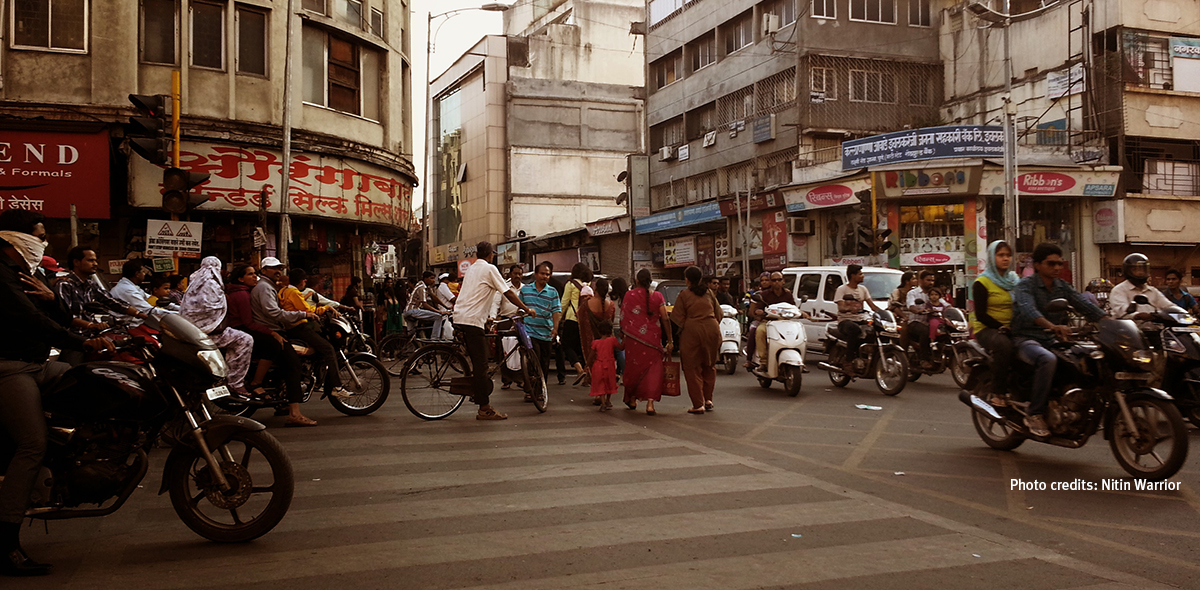Mr Deshpande, a 63-year-old resident of Pune — a metropolitan city in a western Maharashtra — wishes he could take his 4-year-old granddaughter Anaika for a leisurely stroll on the streets outside his home. However, the fear of wading through traffic due to the absence of footpaths on most streets in the city has robbed him of this simple pleasure. Even where footpaths do exist, he fears knocking his own knees while climbing on and off them, and also fears the possibility of his granddaughter running into a utility box sometimes placed in the middle of a footpath.
While strolling on the city’s streets is a desirable activity for Mr Deshpande, for many individuals in Pune and most other Indian cities, the ability to walk and cycle safely is essential to earn a living and access education. In most Indian streets, more than a third of all trips are made on foot and cycle every day. All public transport users also generally walk at the start and end of their journeys. Yet, walking and cycling have turned into undesirable adventure sports in our cities.
To restore the dignity of all road users other than just the drivers, the Pune Municipal Corporation (PMC) has developed a unique set of Urban Street Design Guidelines (USDG) which give clear priority to walking, cycling, and public transport. By setting standards for the elements of street design and providing a collection of street design templates catering to the needs of all road users, this manual illustrates how good design can transform Pune’s streets into safer and more livable public spaces. It clearly breaks away from the implicitly assumed paradigm that ‘streets are for vehicles’.

The launch of the manual comes in the wake of rapid urbanisation that has resulted in the streets of Pune getting clogged with more and more vehicular traffic every passing year. The drastic increase in motor vehicles, especially two wheelers has pushed pedestrians and cyclists to the very edge of the street, with footpaths most often disappearing from the street section. On the few streets where footpaths dos exist, speeding motorists driving on them during peak hours is a common sight. Once a ‘cycle city’, Pune has now deteriorated into a heavily ‘motorised city.’
Apart from pedestrians and cyclists, the needs of public transport users are also ignored. Finding space to locate bus stops and manoeuvring city buses through the heavy traffic have become increasingly challenging. Poor allocation of street space for walking, cycling, and public transport has made it extremely inconvenient to use these sustainable modes of transport — leading to a dip in their modal share. Over the last five years, cycling mode share has reduced by half while public transport use has fallen by a quarter.
Keen to rewrite street hierarchy by putting pedestrians, cyclists, and public transport users at the top, PMC with support from private consultant VK:a architecture [1] [2] [3] developed the manual. The preparation of this document was very closely guided and reviewed by the Institute of Transportation and Development Policy (ITDP) as well as Pedestrians First (a local NGO). The process, which witnessed enthusiastic participation from different levels of PMC officers — right from the junior engineers to the Commissioner — was unprecedented in the Pune Corporation.
The manual aims to support the transformation of all streets in the city into ‘complete streets’ with wide and continuous footpaths, safe crossings, separate cycle tracks (on selected streets), organised on-street parking, and uniform carriageways. It establishes the proposed street typology for Pune, offers detailed guidance on designing different types of street elements — including safety elements and multi-utility zone elements — along with a set of detailed drawing templates for designing streets and intersections. The final section provides insights into the processes involved in the design and implementation of street design projects.

Caption: A design template from the USDG illustrating section and detailing for 15 m right of way
This simple and easy-to-use manual is a handy reference for planners and designers working on street design as well as for PMC engineers carrying out execution on-site. The manual simplifies street design into a three step process: Determine the available right-of-way, identify the character of the street from the surrounding land uses, and finally choose the correspondingly right template. With a total of 50 templates and right-of way (ROW) ranging from 6m to 60m including sections with bus rapid transit (BRT), the guide provides references for all possible street sections.
The launch of the manual comes at the most opportune time for Pune. The PMC, with support from ITDP is focused on implementing sustainable solutions in the city. With all new road construction and repairs guided by the USDG, Pune’s streets will soon be transformed into great people-friendly public spaces, which promote and encourage walking, cycling and public transport.
Download the document here.







